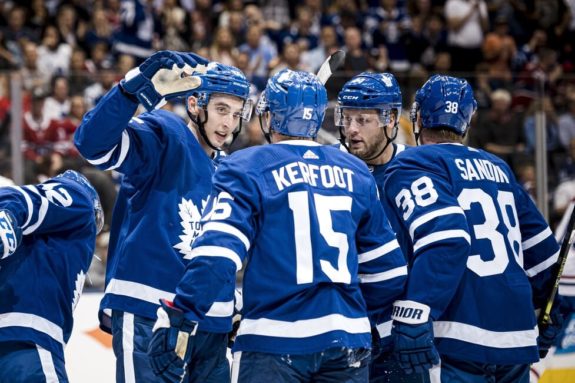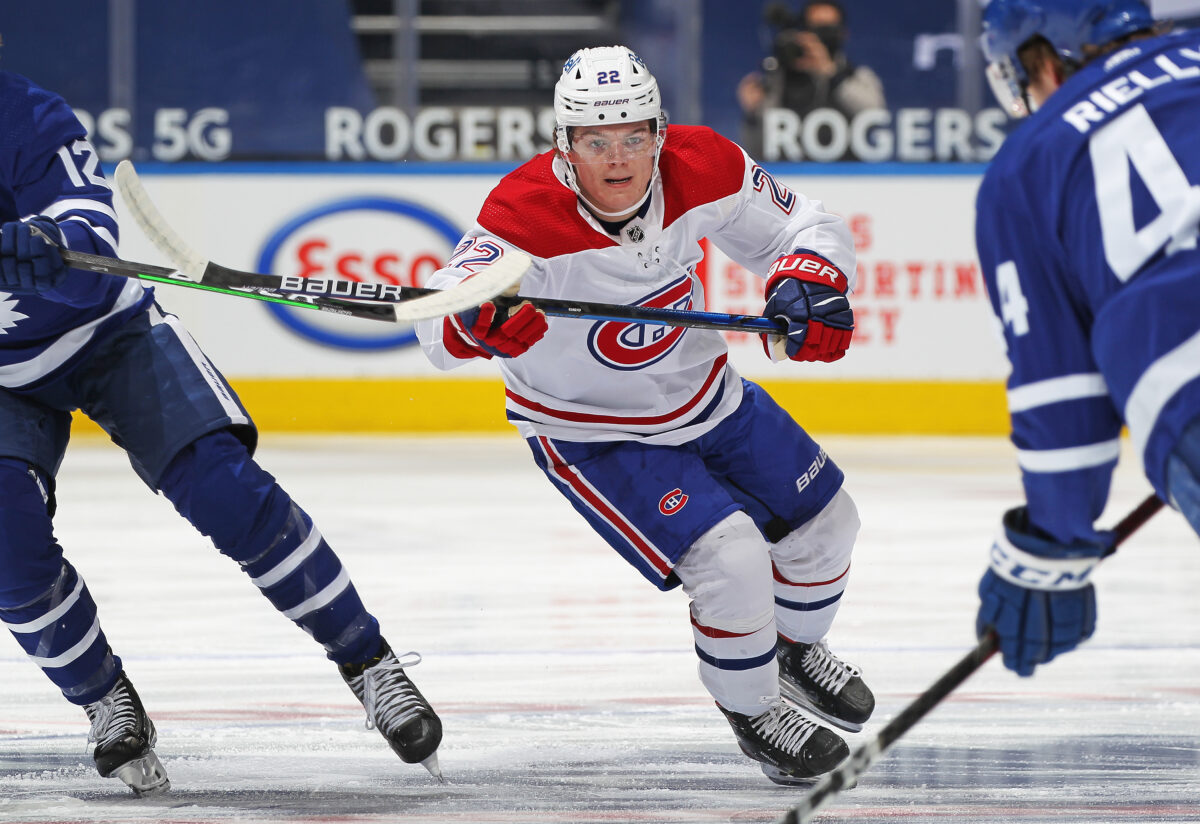If someone would have told the Montreal Canadiens at the outset of their series with the Toronto Maple Leafs that they would be heading back home tied 1-1, they would have taken it. Granted, it’s not the commanding 2-0 lead on the road they could have had, had they played (a lot) better in their 5-1 Game 2 defeat. Nevertheless, they still stole home-ice advantage with the victory in Game 1. They can’t lose sight of that fact and start to panic.
As expected, the Leafs were able to come out in full force in Game 2, despite the injury to John Tavares. The common expression is hockey is a game of adjustments and the Leafs made theirs. Now it’s the Canadiens’ turn. While the Habs have many to make ahead of Game 3, they’re their adjustments to make, meaning the next game is still theirs to win (or lose). As long as they look to the proper takeaways from Game 2, they should be all right:
3. Kotkaniemi Proves He Belongs in Lineup
In his playoff debut this postseason, after scoring the game-opening goal, Jesperi Kotkaniemi made a four-fingered gesture to the stands. Potentially interpreted as a sign of the four horsemen of the apocalypse, with Kotkaniemi having scored his first point in 13 games and his first goal in 25, it was actually a show of solidarity with the other Canadiens regulars scratched in the stands, including Cole Caufield and Alexander Romanov.
After having struggled down the stretch, Kotkaniemi was similarly scratched in Game 1 before being inserted in the lineup for an injured Jake Evans. There is little doubt at this juncture that Kotkaniemi is an NHL-caliber player. However, he justified interim head coach Dominique Ducharme’s faith in him and hopefully restored some confidence in his game by notching the goal in question, on which he went to the net and put home a loose puck.

Admittedly, it was an up-and-down game for Kotkaniemi. Despite the goal, he did take a penalty, a cross-checking call on Morgan Rielly that led to Rasmus Sandin’s 3-1 go-ahead goal in the second period that effectively put the game out of reach. It was the third straight of four total in the frame against the Habs, which permanently shifted the momentum in the Leafs’ favor.
2. Leafs Click on Power Play, Awakening Sleeping Giant?
You could make a case that Kotkaniemi’s cross-checking penalty was the only legitimate “playoff” penalty called against the Habs. To elaborate, Canadiens head coach Dominique Ducharme said after the game he didn’t expect it to be called as it was.
For example, Brendan Gallagher’s high-sticking call (the first of the four in the second) took place effectively in a scrum at a whistle and Artturi Lehkonen’s slashing call took place during a goal-mouth scramble literally seconds after the Canadiens killed off the first. Nevertheless, those were each penalties by the strict letter of the law.
Could the referees have called more penalties against the Leafs? Sure. However, the Canadiens were still the ones that took liberties with the opposition, not the referees. The Leafs did too, admittedly. And while the Canadiens only had a single power play to show for it, off a Zach Hyman holding call on Phillip Danault in the first period, that was arguably the softest call in the game. The Habs should have taken it as a warning. They didn’t. Now the Canadiens potentially need to contend with a Leafs power play that scored two goals in a game for the first time since March 3.
Ducharme further shot himself in the foot by challenging largely phantom goaltender interference on the part of Joe Thornton on the Sandin goal. While the consensus behind the Canadiens’ bench was that Thornton’s stick got in the way of Carey Price’s ability to make a save, replays showed minimal contact if any between the two players, leading to a failed challenge and yet another penalty to kill.

True, the Canadiens did kill it off, but it was far from a no-harm, no-foul situation as the Canadiens wasted another two minutes trying to regain momentum. As Sandin scored at 13:20 and the delay-of-game call ended with less than five minutes to go, the period, in which the Canadiens got outshot 20-6, was lost. As was the game at that point in some respects and the Canadiens only have themselves to blame. Any argument to the contrary on the part of the Canadiens can only reasonably be attributed to gamesmanship and an attempt to get more calls go their way in Game 3.
1. Time for Caufield?
With the Canadiens having scored just three times in two games, there’s a need for more offense in the lineup. Thankfully, the Canadiens have Caufield sitting in the press box. With the Canadiens having the benefit of last change at home and Ducharme able to shelter the rookie as he so desires, there’s a good chance he’ll take the opportunity to give the young winger his first taste of playoff action Monday, when the teams face off at 7 pm Eastern.
One likely candidate to be scratched in his place is Lehkonen, who failed to get register a shot in Game 2, also taking the inopportune penalty of his. Right off the bat, the switch should generate more offense, as Caufield is more of a finisher to be modest. However, expectations should be realistic.
At this stage of his career, Caufield is no savior, nor should the pressure of being one be placed at his skates. He did score four goals in 10 regular-season games (33-goal pace), but it’s a small sample size and, with playoff hockey being tighter-checking, there are no guarantees the hypothetical move from the press box pays off exactly as many Habs fans imagine it will (or at all). Caufield is not a silver bullet. He is a 20-year-old and it’s a team sport, meaning for the Habs to have a chance at winning the game they must stick to their strengths.

It may have improved over the last eight games of the regular season (89.5%), but by and large a 23rd-ranked penalty kill at 78.5% overall, during which you’re forced to spend time in your own zone, is not one of them. Furthermore, the more time the Canadiens spend killing penalties, the less chance the Habs will have to play Caufield. Food for thought.